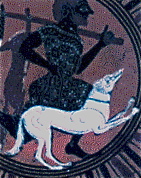 By Adrienne Mayor (Wonders & Marvels contributor)
By Adrienne Mayor (Wonders & Marvels contributor)
Chasing game (rabbits, deer, bear, boar) for food and sport was extremely popular in classical antiquity, and dog owners took good care of their hunting companions. Ancient hunting manuals by two Greek historians, Xenophon (b. 430 BC) and Arrian (AD 86) preserve lively practical advice on raising hounds.
So, if you lived in Athens at the time of Socrates and owned a Laconian hunting hound like those depicted on Greek vases, what would you feed them? Ordinary pups get barley bread softened with cow’s milk or whey. But more valuable puppies eat their bread soaked in sheep or goat milk. You might add a little blood from the animal you expect your puppy to hunt. At dinner with your family, you scoop soft chunks of bread from the center of a loaf to wipe grease from your fingers—and toss them to your dog, supplemented with bones and other table scraps, perhaps even a basin of meat broth. After a sacrifice or banquet, you make a special treat: a lump of ox liver dredged in barley meal and roasted in the coals. Naturally, as a matter of professional courtesy, you share any rabbits, stags, or boars with your faithful hunting partners.
Was such a diet nutritious? The idea that dogs’ principle sustenance must be red, raw meat is a popular misconception. In the wild, canines hunt plant- and grain-eating animals. At the kill, they first eat the stomach filled with predigested grass and cereals, and then the organs, before turning to the flesh. They often gnaw the bones, thus assuring a balanced meal with vitamins and minerals. That Greek dogs thrived on their grain and meat diet is confirmed by Aristotle (b. 384 BC), who remarked that a hard-working Laconian hound usually lived to be 10 or 12 years old, and other breeds reached the age of 14 or 15. Today’s average 50 pound dog can expect the same lifespan as Xenophon’s Laconian hounds.
Should your dog suffer from worms, wheat awns (whiskers) are recommended. But a more aggressive treatment is Artemesia, wormwood, a natural antihelmintic to expel parasitic worms. What if your neighbors complain that your hound keeps them awake at night? You resort to the ancient cure for excessive barking and conceal a live frog in a lump of his food.
About the author: Adrienne Mayor is a Research Scholar in Classics and History of Science, Stanford University. She is the author of “Greek Fire, Poison Arrows & Scorpion Bombs: Biological and Chemical Warfare in the Ancient World” (2009) and “The Poison King: The Life and Legend of Mithradates, Rome’s Deadliest Enemy,” a nonfiction finalist for the 2009 National Book Award.
